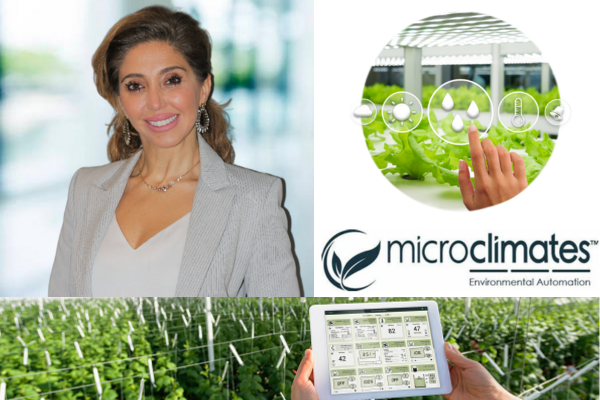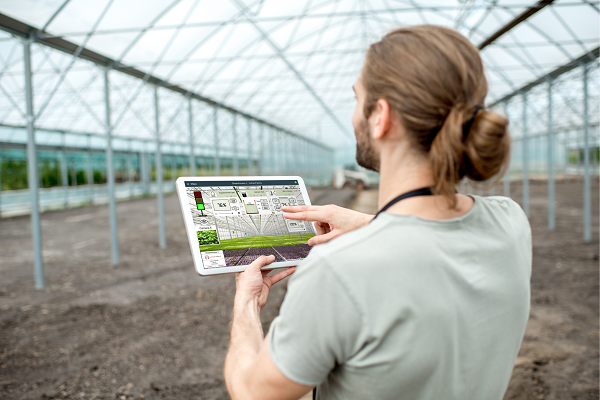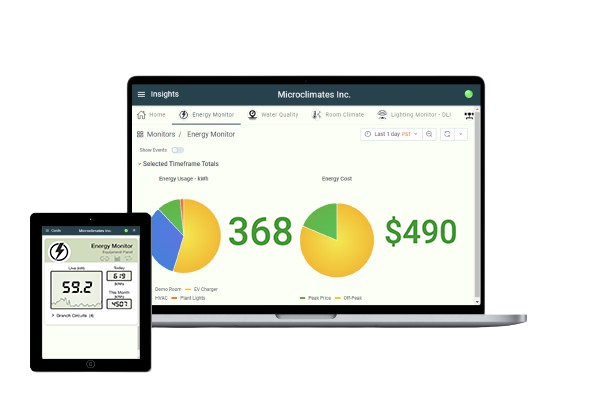
Integration, Efficiency, and the Future of CEA: Q&A With Microclimates Founder Neda Vaseghi
Controlled Environment Agriculture (CEA) is experiencing rapid growth, driven by technological advancements. At the forefront of this innovation is Microclimates, a platform that unifies various CEA systems, offering a holistic view of operations. By integrating data and controls from different sources, Microclimates helps growers improve productivity, manage resources efficiently, and ensure high-quality yields. In our conversation, Microclimates Founder Neda Vaseghi shares how their solutions are paving the way for sustainable and scalable CEA practices, setting new industry standards in California and beyond.
 Q: The MicroClimates software platform integrates various aspects of controlled environment agriculture, such as lighting, climate control and irrigation. Can you explain how this integration benefits greenhouse operators and vertical farm growers in terms of productivity, quality, and efficiency?
Q: The MicroClimates software platform integrates various aspects of controlled environment agriculture, such as lighting, climate control and irrigation. Can you explain how this integration benefits greenhouse operators and vertical farm growers in terms of productivity, quality, and efficiency?
At Microclimates, our vision from the start has been to provide a hardware-agnostic and user-friendly interface. Over the years, we have partnered with numerous companies to offer both wired and wireless (LoRaWAN) solutions. Staying true to our hardware-agnostic approach, we have developed a robust technology platform that integrates with various systems and programming languages.
Integrating the various aspects, can significantly benefit greenhouse operator and vertical farm growers in the following ways:
- Improve productivity & streamline operation: By unifying siloed systems onto a single platform, we are able to streamline data integration for continuous improvement. These controls monitor conditions, facilitate inter-system communication, and provide a comprehensive facility-level view. This allows everyone to observe how mission-critical systems respond. Greater efficiency is achieved through ongoing engagement with data from integrated controls and analysis platforms. Alerts and reports offer insights to help growers update Standard Operating Procedures (SOPs) and control sequences. As changes are implemented, benchmarking key performance indicators can verify improvements. Over time, more systems can be integrated and controlled from the unified platform, enabling remote control and automation for seamless decision-making across all systems. Like an orchestra, these systems work together harmoniously for optimal performance.
- Resource Management: The Microclimates system offers sub-metering energy monitoring, enabling operators to track energy consumption of specific components like lighting and HVAC systems. This data, combined with local utility peak demand hours and fees, allows for operational adjustments to support energy savings. Optimizing lighting schedules and intensities reduces electricity consumption, while precise climate control minimizes the energy required for heating, cooling, and ventilation. Additionally, automated and precise irrigation systems reduce water waste and ensure that nutrients are delivered in the right amounts at the right time, enhancing resource use efficiency and reducing costs.
- Data Today & Data Tomorrow: Data-Driven decisions are at the core of integrated software platforms, which not only collect and analyze data from various sensors and control systems but also empower growers to make insightful decisions for their operation today. By harnessing this data-driven approach, operators can identify trends and adjust strategies proactively to optimize growth conditions, enhancing productivity and quality. Moreover, the collected data serves as a valuable resource for future advancements, enabling machine learning and AI applications to further revolutionize CEA. Recognizing that data is power, the platform emphasizes the importance of collecting heterogeneous data from various sources, laying the foundation for the intelligent automation of the future, including machine learning & AI.
- Scalable Growth With Cost Efficiency: The system is designed with scalability in mind, allowing it to grow alongside an operation. An operator can start their integration journey with one or two systems and expand as needed, ensuring that the system evolves with their business. This flexibility is crucial for keeping operational costs affordable, especially when competing with outdoor agriculture prices. By integrating various aspects of controlled environment agriculture, the system makes it easier to scale operations without a proportional increase in labor or operational expenses. As the operation grows, the software adeptly manages the increased complexity, facilitating a seamless expansion while maintaining a close watch on OPEX. This approach ensures that efficiency and cost-effectiveness are prioritized, supporting sustainable growth for greenhouse operators and vertical farm growers.
- Quality: Quality is a key benefit of integrated systems, which provide uniform conditions that result in consistent plant quality. Each plant receives the same care, leading to uniform size, taste, and appearance, crucial for meeting market standards. By minimizing environmental stress through precise control, plants are less likely to develop diseases or pests, resulting in healthier crops with better nutritional profiles and longer shelf lives. Additionally, the ability to tailor the environment to specific crops or growth stages, such as vegetative or flowering, allows growers to maximize the quality of a diverse range of plants.
 Your collaboration with ERI for the CalNEXT study on the benefits of integrated control systems for greenhouses and indoor farms is an exciting initiative. How do you envision these findings shaping the future of controlled environment agriculture in California and beyond?
Your collaboration with ERI for the CalNEXT study on the benefits of integrated control systems for greenhouses and indoor farms is an exciting initiative. How do you envision these findings shaping the future of controlled environment agriculture in California and beyond?
The findings from our collaboration with ERI on the CalNEXT study have the potential to significantly transform the CEA industry in California and set a precedent for similar advancements globally. By focusing on the integration of smart controls for lighting, HVAC, and irrigation systems, we aim to demonstrate substantial energy savings and operational efficiencies in greenhouses and indoor farms.
Overall, the findings from the CalNEXT study will be instrumental in driving the future of controlled environment agriculture by promoting sustainable practices, reducing energy consumption, and improving crop productivity. This project represents a significant step towards achieving California’s climate goals and setting a benchmark for global agricultural practices.
Here is more detail in how we envision the study might shape the future of CEA. I certainly hope it’s the first of many studies on this topic.
Impact on California’s CEA Industry:
- Energy Efficiency and Cost Reduction: The implementation of smart environmental controls will enable growers to optimize their resource usage, thereby reducing energy consumption and operational costs. This is crucial in California, where energy prices are high, and there is a strong emphasis on sustainability and reducing carbon footprints. We must identify ways to reduce our energy consumption in CEA. A lot of emphasis has been placed on LED lights, including rebates. Very little on integrated controls.
- Enhanced Crop Yields and Quality: Intelligent control systems provide precise monitoring and adjustments to environmental conditions, ensuring optimal growth conditions for crops. This can lead to higher yields and improved quality of produce, benefiting both growers and consumers.
- New Utility Rebate Programs: The goal for the study is to identify new rebate programs for utilities to support the adoption of these technologies. This financial incentive will encourage more growers to invest in smart control systems, accelerating the adoption rate and broadening the impact across the state.
Broader Implications:
- Scalability and Replicability: The technology roadmap and insights gained from this study will serve as a model for other regions and countries. The demonstrated benefits in California can be replicated in other areas facing similar challenges, promoting global advancements in CEA.
- Innovation and Industry Standards: By collaborating with leaders such as Cornell University GLASE consortium & ERI, we are setting new standards for energy efficiency and sustainability in CEA. This collaboration fosters innovation and encourages the development of next-generation technologies that can further enhance the industry.
- Equity and Inclusion: CalNEXT is committed to ensuring that all Californians benefit from clean and healthy environments. The insights from this study will help us identify ways to support equity and inclusion in delivering these technologies, ensuring that small and disadvantaged growers also have access to the benefits of smart environmental controls.
 With an extensive background in food safety – and considering your upcoming speaking role at the CEA Summit in Virginia – what do you see as the most critical food safety challenges currently facing the indoor agriculture industry? And, how does MicroClimates’ technology contribute to enhancing food safety in CEA operations?
With an extensive background in food safety – and considering your upcoming speaking role at the CEA Summit in Virginia – what do you see as the most critical food safety challenges currently facing the indoor agriculture industry? And, how does MicroClimates’ technology contribute to enhancing food safety in CEA operations?
The most critical food safety challenges in indoor agriculture revolve around pathogen control, water quality, cross-contamination, and traceability.
Often, the challenge is exacerbated because food safety is not adequately addressed during the design or build-out phase of agricultural facilities. When buildings and irrigation systems are not designed with food safety in mind, it becomes a much larger challenge to implement effective monitoring & management protocols. As for traceability, effective traceability systems are crucial in indoor agriculture for quickly identifying and containing contamination incidents. By tracking produce from seed to sale, these systems ensure compliance with regulatory standards like Good Agricultural Practices (GAP) and facilitate swift recall management when necessary. This capability enhances transparency across the supply chain, bolstering consumer confidence in product safety and quality. Robust traceability not only safeguards public health by enabling precise removal of affected batches but also preserves the industry’s reputation for reliability and responsibility in food safety practices.
In 2006, a spinach recall due to contamination with E. coli bacteria significantly impacted consumer confidence and sales. The outbreak, linked to spinach grown in California, resulted in over 200 reported illnesses across multiple states, with several cases of severe illness and even deaths. This incident led to a widespread recall of spinach products from grocery stores nationwide, causing financial losses for growers and distributors alike and prompting consumers to avoid spinach products for a period.
Similarly, in 2011, a cantaloupe recall was initiated due to a Listeria monocytogenes outbreak traced to a farm in Colorado. The contaminated cantaloupes were linked to numerous illnesses and deaths across multiple states. The outbreak had severe consequences for the cantaloupe industry, with consumers avoiding purchases due to concerns over food safety. This led to a decline in sales and financial losses for growers and distributors, highlighting the devastating impact of foodborne illness outbreaks on consumer trust and market demand.
These recalls underscore the critical importance of robust food safety practices, including traceability systems, to quickly identify and remove contaminated products from the market. Such incidents serve as reminders of the need for stringent adherence to food safety standards and continuous efforts to maintain consumer confidence in the safety and quality of agricultural products.
Microclimates’ technology focuses on environmental automation. We have developed an easy-to-deploy mapping application that allows companies to upload a map, blueprint, or any image of their facility into the platform. This application can overlay various types of data onto these maps. Currently, we specialize in displaying environmental data, such as temperature and humidity. However, our platform is designed for integration and we welcome partnerships with companies interested in overlaying food safety data onto their facility maps. Tracking food safety data alongside environmental metrics can provide a comprehensive view of facility conditions, enhancing the ability to monitor and manage both environmental and food safety parameters effectively.
Overall, currently, our platform’s impact on food safety in CEA is limited. However, I am optimistic that we can identify customers who are eager and have the capacity to delve into integrating and aligning food safety protocols with our environmental automation capabilities. This proactive approach will enable us to enhance our platform’s contribution to ensuring safe and secure agricultural practices in controlled environments.
 Given your years of experience across various facets of the industry, what do you see as the biggest challenges and opportunities facing the CEA sector today? How is MicroClimates positioning itself to address these?
Given your years of experience across various facets of the industry, what do you see as the biggest challenges and opportunities facing the CEA sector today? How is MicroClimates positioning itself to address these?
Challenges:
- Energy Consumption: One of the biggest challenges is energy consumption. CEA facilities often require significant energy for lighting, HVAC, and other systems. Lighting and HVAC alone consume about 70% of the energy. Managing and reducing energy consumption while maintaining optimal growing conditions is a major challenge. At Microclimates, we have launched a sub-metering energy monitoring wireless solution to address this issue. This allows operators to input their peak demand utility fees while measuring the energy consumption of their facility at a granular level. For example, our solution enables the differentiation of energy usage for specified periods of lighting versus HVAC or down to the equipment level—information that cannot be gathered simply from a utility bill. Understanding consumption and costs at such a granular level can be an eye-opener. This detailed information can be used to make modifications, resulting in significant cost savings.
- Initial investments: Another challenge is the initial investment and ongoing costs associated with setting up advanced CEA systems, including infrastructure, technology, and automation. At Microclimates, we have stayed hardware agnostic, allowing our platform to integrate seamlessly with both existing environmental systems and new ones. As hardware prices continue to decline, our hardware-agnostic approach enables us to offer a very affordable entry fee for automation. This flexibility helps clients start with a cost-effective solution and scale their systems as needed over time, without being tied to specific hardware vendors. This approach not only reduces initial investment costs but also provides the adaptability required for long-term growth and efficiency.
- Connectivity: To enable remote environmental monitoring and controls, operators rely heavily on solid internet connectivity. This model typically thrives in urban areas or developed regions where robust internet infrastructure is readily available. However, a significant challenge lies in ensuring that the benefits of advanced agricultural technology extend to underserved communities and bridging the digital divide. At Microclimates, we recognize this challenge and have partnered with edge computing hardware solutions to extend connectivity to areas with limited internet access. Through this partnership, we aim to first lay the foundation for connectivity and subsequently introduce automation solutions tailored for both indoor and outdoor farms. By addressing connectivity barriers, we can empower all farmers, regardless of their location, to leverage cutting-edge technology for enhanced efficiency and productivity.
Opportunities:
- Technological Advancements: A significant opportunity in the CEA sector lies in technological advancements, particularly in LED lighting, HVAC systems, automation, and AI. Innovations in LED lighting and HVAC systems can greatly enhance energy efficiency and boost crop yields, making production more sustainable and cost-effective. Additionally, the integration of automation and AI technologies can optimize growing conditions, reduce labor costs, and increase scalability, allowing for more consistent and higher quality outputs. Microclimates Inc. is capitalizing on this opportunity by not only integrating various technological silos into a common user interface but also collecting vast amounts of data to support ongoing intelligent automation. This comprehensive approach ensures the continuous improvement and sustainability of CEA operations, setting a new standard for the industry both today and in the future.
- Sustainability and environmental impact: Both are key advantages of CEA systems, which typically use significantly less water than traditional agriculture, addressing critical water scarcity issues. CEA also supports urban agriculture initiatives, reducing food miles and providing fresh produce to urban populations. Environmental automation plays a crucial role in these advancements by optimizing resource usage and minimizing waste, leading to more sustainable indoor farming practices. Additionally, Microclimates Inc. enhances these benefits by offering sub-metering energy monitoring, enabling continuous improvement in lowering energy consumption. This comprehensive approach not only boosts the sustainability of CEA operations but also sets a new standard for efficient and responsible indoor farming practices.
- Year-round production: CEA ensures a consistent supply of fresh produce, independent of seasonal changes. This is particularly crucial given my years in food safety and firsthand experience with the challenges posed by climate instability in Salinas, CA, which impacts all agricultural products, including almonds. With CEA, we have a real opportunity to make a difference by maintaining a stable supply chain despite external environmental fluctuations. Microclimates Inc. plays a pivotal role in this by offering scheduling for seasonal automation and data analytics, enabling the replication of successful production cycles. This capability not only supports continuous and reliable production but also enhances the overall sustainability and efficiency of indoor farming practices.
 Your passion for innovation and sustainability is evident. What is your long-term vision for Microclimates, and how do you plan to continue driving innovation in the indoor growing sector to create value for customers, partners & stakeholders?
Your passion for innovation and sustainability is evident. What is your long-term vision for Microclimates, and how do you plan to continue driving innovation in the indoor growing sector to create value for customers, partners & stakeholders?
Thank you for recognizing our passion for innovation and sustainability. At Microclimates, our long-term vision revolves around pioneering advancements in the indoor growing sector that enhance productivity, efficiency, and sustainability. We are committed to driving innovation by expanding our integrations with as many companies as possible, fostering collaboration even with competitors to create a unified industry ecosystem rather than silos. Our goal is to broaden our integration portfolio to support the entire industry and facilitate seamless operations for our customers, partners, and stakeholders.
Data analytics will be pivotal in our strategy, leveraging big data and AI-driven insights to revolutionize crop forecasting, optimize yield management, and enable predictive maintenance. This approach empowers our customers to make informed, data-driven decisions that enhance operational efficiency and maximize profitability.
Additionally, we are deeply invested in two specific areas: academia and underserved communities. We plan to continue our close collaboration with academia to drive technological advancements in CEA, ensuring we remain at the forefront of innovation. Simultaneously, we are committed to partnering with companies that share our values in addressing the needs of underserved communities, using our technology to promote food security and sustainability.
By focusing on these initiatives, Microclimates aims to lead the way in sustainable indoor growing practices while fostering collaboration, innovation, and social responsibility across the industry. Together with our partners and stakeholders, we are dedicated to shaping the future of CEA through technology and inclusive community support.
Learn more about Microclimates here.
controlled environment agriculture, energy savings, environmental controls, greenhouse, HVAC, indoor farms, integrated systsms, irrigation, lighting, smart controls, sustainability